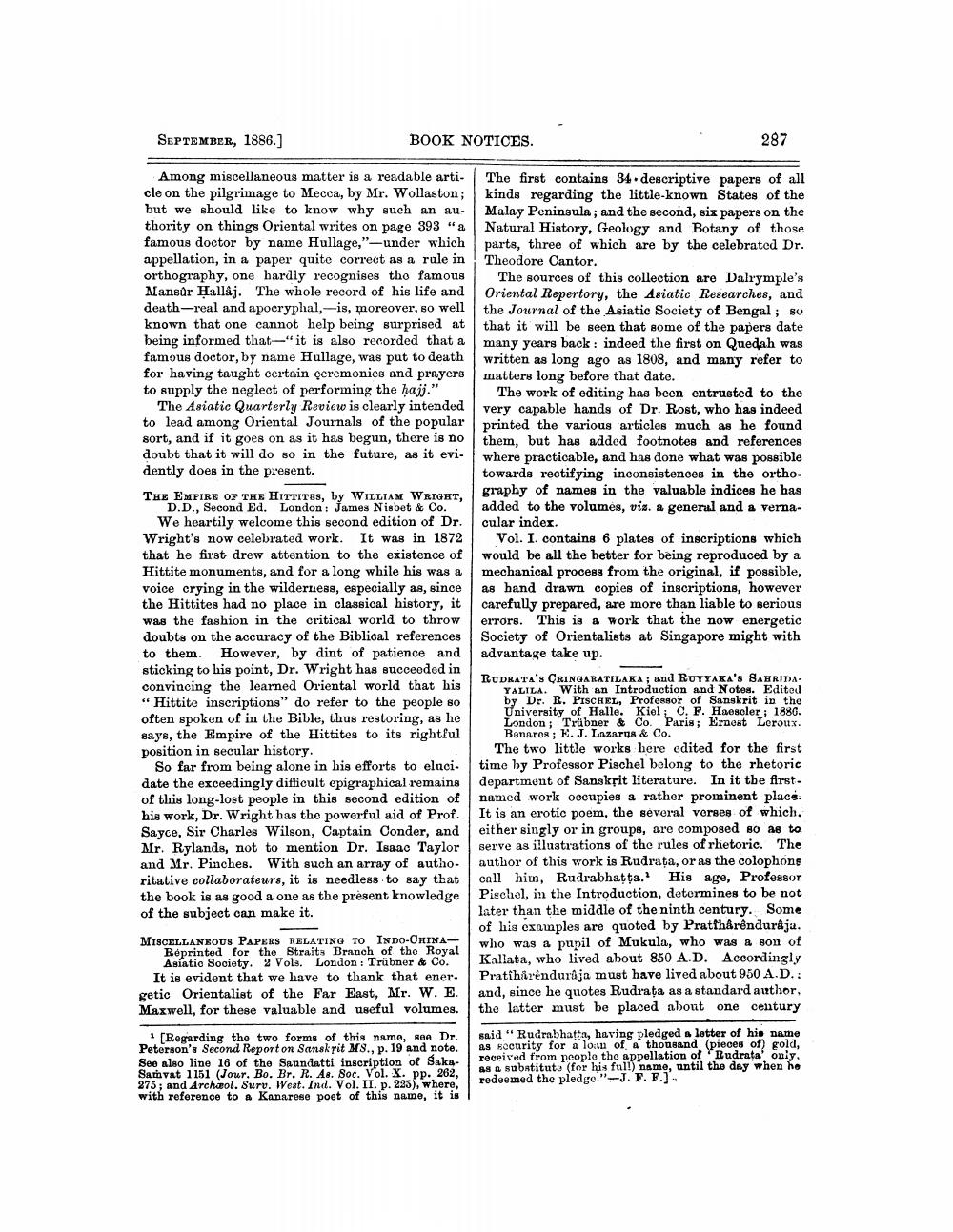________________
SEPTEMBER, 1886.]
BOOK NOTICES.
287
Among miscellaneous matter is a readable arti- cle on the pilgrimage to Mecca, by Mr. Wollaston; but we should like to know why such an au. thority on things Oriental writes on page 393 "a famous doctor by name Hullage,"-under which appellation, in a paper quite correct as a role in orthography, one hardly recognises tho famous Mansur Halláj. The whole record of his life and death-real and apocryphal,-is, moreover, so well known that one cannot help being surprised at being informed that it is also recorded that a famous doctor, by name Hullage, was put to death for having taught certain ceremonies and prayers to supply the neglect of performing the haj."
The Asiatic Quarterly Review is clearly intended to lead among Oriental Journals of the popular sort, and if it goes on as it has begun, there is no doubt that it will do so in the future, as it evidently does in the present. THE EMPIRE OF THE HITTITES, by WILLIAM WRIGHT,
D.D., Second Ed. London: James Nisbet & Co. We heartily welcome this second edition of Dr. Wright's now celebrated work. It was in 1872 that he first drew attention to the existence of Hittite monuments, and for a long while his was a voice crying in the wilderness, especially as, since the Hittites had no place in classical history, it was the fashion in the critical world to throw doubts on the accuracy of the Biblioal references to them. However, by dint of patience and sticking to his point, Dr. Wright has succeeded in convincing the learned Oriental world that his " Hittite inscriptions" do refer to the people so often spoken of in the Bible, thus restoring, as he says, the Empire of the Hittites to its rightful position in secular history.
So far from being alone in his efforts to eluci. date the exceedingly difficult epigraphical remains of this long-lost people in this second edition of his work, Dr. Wright has the powerful aid of Prof. Sayce, Sir Charles Wilson, Captain Conder, and Mr. Rylands, not to mention Dr. Isaac Taylor and Mr. Pinches. With such an array of authoritative collaborateurs, it is needless to say that the book is as good a one as the present knowledge of the subject can make it.
The first contains 34.descriptive papers of all kinds regarding the little-known States of the Malay Peninsula; and the second, six papers on the Natural History, Geology and Botany of those parts, three of which are by the celebrated Dr. Theodore Cantor.
The sources of this collection are Dalrymple's Oriental Repertory, the Asiatic Researches, and the Journal of the Asiatic Society of Bengal; 80 that it will be seen that some of the papers date many years back : indeed the first on Quedah was written as long ago as 1808, and many refer to matters long before that date.
The work of editing has been entrusted to the very capable hands of Dr. Rost, who has indeed printed the various articles much as he found them, but has added footnotes and references where practicable, and has done what was possible towards rectifying inconsistences in the orthography of names in the valuable indices he has added to the volumes, vis a general and a vernacular index.
Vol. I. contains 6 plates of inscriptions which would be all the better for being reproduced by a mechanical process from the original, if possible, as hand drawn copies of inscriptions, however carefully prepared, are more than liable to serious errors. This is a work that the now energetic Society of Orientalists at Singapore might with advantage take up. RUDRATA'S CRINGARATILAKA; and RUYYAXA'S BAHRIDA
YALILA. With an Introduction and Notos. Edited by Dr. R. PISCHEL, Professor of Sanskrit in the University of Halle. Kiel; C. F. Haescler; 1880. London ; Trübner & Co. Paris; Ernest Loroux. Benaros; E. J. Lazarus & Co. The two little works here edited for the first time by Professor Pischel belong to the rhetoric department of Sanskrit literature. In it the first. named work occupies a rather prominent placé. It is an erotic poem, the several verses of which. either singly or in groups, are composed so as to serve as illustrations of the rules of rhetoric. The author of this work is Rudrata, or as the colophons call him, Rudrabhatta. His age, Professor Pischol, in the Introduction, determines to be not later than the middle of the ninth century. Some of his examples are quoted by Pratthårêndurâja. who was a pupil of Mukula, who was a son of Kallata, who lived about 850 A.D. Accordingly Pratihirènduraja must have lived about 950 A.D. : and, since he quotes Rudrata as a standard author, the latter must be placed about one century
MISCELLANEOUS PAPERS RELATING TO INDO-CHINA
Reprinted for the Straits Branch of the Royal Asiatic Society. 2 Vols. London: Trübner & Co. It is evident that we have to thank that ener. getic Orientalist of the Far East, Mr. W. E. Maxwell, for these valuable and useful volumes
[Regarding the two forms of this namo, se Dr. Petoron's Second Report on Sanskrit M8., p. 19 and note. See also line 10 of the Saundatti inscription of SakaSamvat 1151 (Jour, Bo. Br. R. As. Soc. Vol. X. pp. 262, 275; and Archäol. Surv. West. Ind. Vol. II. p. 225), where, with reference to a Kanarese poet of this name, it is
said " Rudrabhatta, having pledged a letter of his name as security for a lon of a thousand pieces of) gold, received from people tho appellation of Rudrata' only, as a substituto (for his ful!) name, until the day when he redeemed the pledge."-J. F. F.]




